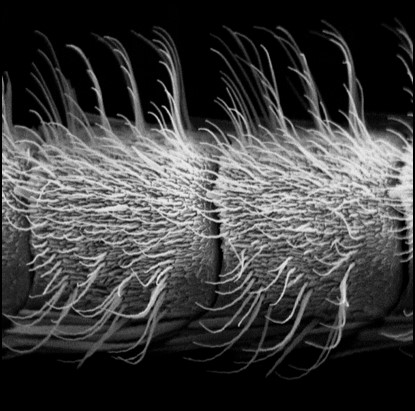Pheromone Detection in Moths
Molecular elements of pheromone detection: receptors, binding proteins, SNMPs
The females of many moth species release a complex blend of sex pheromone components to lure the males and signal their own position. Male moths have the remarkable ability to detect lowest amounts of the signal molecules and to discriminate them from structurally similar pheromones of other species. The detection of species-specific pheromones by the males is mediated by specialized olfactory sensory neurons on the antenna that project their sensory dendrite into hair-like sensilla.
Pheromone binding proteins (PBPs) are supposed to take over hydrophobic pheromone molecules from the air and to mediate the transport through the aqueous sensillum lymph towards pheromone receptors (PRs) residing in the dendritic membrane of olfactory sensory neurons.

Visualization of pheromone receptor- (red ) and PBP- (green) expressing cells in the male antenna of Heliothis virescens. Two-color fluorescence in situ hybridization (FISH) on a tissue section.
We study whether male moths use distinct „functional units" of binding proteins and receptors to detect the major and minor components of the female sex pheromone blend. Moreover, we investigate the specific contribution of PBPs as well as PRs to the sensitivity and specificity of pheromone detection systems and try to illuminate the functional role of the so-called sensory neuron membrane protein 1 (SNMP1) which is supposed to act as co-receptor with PRs and may serve as „docking site" for PBP-pheromone complexes.
Since certain plants odorants that co-exist in the natural environment of males inhibit the electrophysiological response of the pheromone-specific sensory neurons, we assess if receptors, PBPs and SNMP1 are molecular targets of the peripheral inhibition.
Current studies are carried out using the tobacco budworm Heliothis virescens, a model organism of pheromone research and economically important pest insect.






